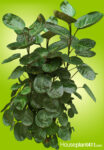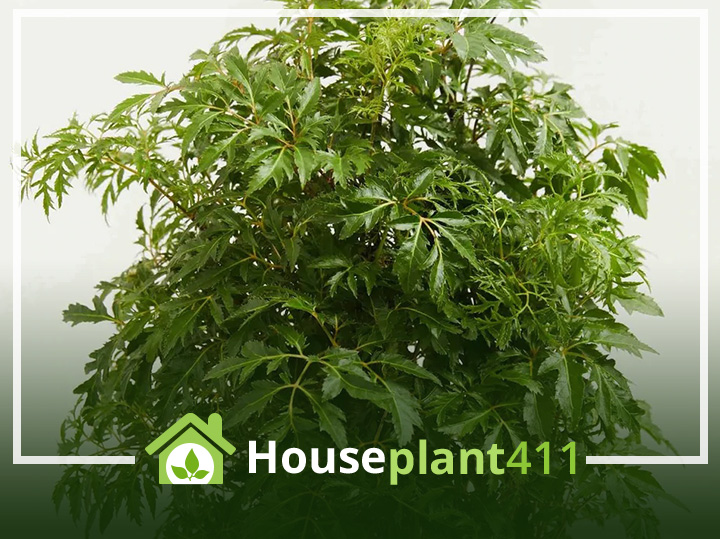About
An Aralia plant, Polyscias, is part of the Araliaceae family, a very large group of plants that includes the popular Hedera ivy (English Ivy plant). If you are getting tired of using dracaenas and palms as tall trees in your home or office, think about using one of the many varieties of the exotic looking aralia.
Aralia Description
Aralia plants have a distinctive, oriental look to them and often have twisted, woody stems or a short, thick, stump for a base. The leaves can be leathery and round like a dinner plate, lacy and fern-like, or even crinkled. Aralia plant leaves may be solid green or variegated with flecks and patterns in green, white, gold, and cream. When small, the plant can be used as a table plant and, as it matures, an impressive floor plant.
Aralia Varieties
Here are the names of some the more popular types that can be used as indoor houseplants.
Ming Aralia((Polyscias fruticose) has green, ferny looking leaves that are divided into multiple leaflets with saw-toothed edges.
Balfour Aralia, also called the Dinner Plate Aralia, (Polyscias Balfouriana) has dark green, round, leaves that resemble a dinner plate.
Fabian Aralia (Polyscias scutellaria ‘Fabian”) has dark green, shiny, scalloped leaves that tend to curve outwards; the leaf underside may have purple tones.
Chicken Gizzard Aralia (Polyscias crispatum), is also called the Geranium Aralia; both names refer to the shape of the plant leaves.
Spinach Leaf Aralia (Polyscias guilfoylei “Crispa”) has crinkled, dark green leaves.




Fabian Aralia Dinner Plate Aralia Spinach Aralia Ming Aralia
Quick Care Tips for an Aralia
Warm temperatures above 60°F (15.6°C)
Medium to bright indirect light
Be careful not to over water especially during winter
Likes high humidity if possible
Conclusion
The unique looking aralia is not a good plant for the novice plant enthusiast. It’s not very forgiving and quickly drops leaves if not cared for properly. Aralia plants are toxic to cats and dogs and should be kept away from small children. Read more about common houseplants that can be dangerous in my book Don’t Feed Me to Your Cat: A Guide to Poisonous Houseplants.
Plant Care
Light
An aralia plant can survive in low light conditions, but grow faster and produce more leaves in medium to bright indirect light.
Water
Too much water, resulting in root rot, is the main reason an aralia plant dies. Allow the top 50% of the soil to dry out before watering. In low light conditions, an aralia plant may need water as little as every 2-3 weeks.
Fertilizer
An aralia plant requires very little fertilizer. Feed every other month when your aralia plant is actively growing with a plant food high in nitrogen diluted to 1/2 the recommended strength.
Temperature
Temperatures between 60°-85° F (15.6°-29.4°C) are best for an Aralia plant.
Humidity
High humidity helps an aralia plant grow better. Dry air, due to low humidity, is one of the main reasons an aralia plant loses leaves.
Flowering
Although an aralia plant doesn’t flower indoors, they can be trained to be a lovely bonsai plant.
Pests
An Aralia plant is more pest resistant than many other indoor plants, but can still get aphids, scale, mealy bugs, and spider mites. Spray an aralia plant frequently with a biodegradable soapy water solution to prevent problems.
Diseases
Aside from root-rot caused by over-watering, an aralia plant is fairly resistant to most houseplant diseases.
Soil
A peat-based, well-aerated, light soil is the best potting mix to use for an Aralia plant. This type of quick- draining medium prevents water from accumulating in the soil and causing root-rot.
Pot Size
For such a large plant, an aralia plant does much better when root-bound. Being in smaller pots also helps the soil dry out faster and prevents over- watering.
Pruning
Trimming the tips of an aralia plant helps promote new growth.
Propagation
The best way to propagate an aralia plant is by stem cuttings. If the stems of the aralia plant are thick, air layering is another good propagation method. Propagating an aralia plant is more successful when temperatures are above 70°F (21.1°C)
Poisonous Plant Info
An aralia plant is a poisonous plant with a #2 toxicity level. All parts of an aralia plant contain saponins which may cause gastrointestinal irritation, nausea, vomiting and diarrhea.
FAQ
How much light your aralia plant gets is important. Weak, drooping branches on an aralia plant indicates that the plant is not getting enough lightt; so the first thing is to move your aralia to a brighter location. The other, more serious cause of drooping branches, may be that you have over-watered your aralia plant and the plant is suffering from root-rot. In this case the limbs of the plant are drooping because they are not getting any water even though the soil may be wet.
It is common for an aralia plant to loose leaves about once a year as long as you see new leaves developing. If there are a lot of leaves falling off and no new growth on your aralia plant, the most serious cause would be over- watering. How you water an aralia plant is important to how well it grows. Be sure to allow the top 50% of the soil to dry out before you water your Aralia plant. Leaf drop on an aralia plant can also occur if the soil gets too dry or if the humidity in the room is too low.
There are many reasons why an aralia plant leaves turn brown: too much fertilizer, too little humidity, using water that has too many chemicals in it, or using water that has passed through a softener (too salty). Try using distilled water or allowing your household water to sit out over night before using it to water your aralia plant. Don’t fertilize your aralia for about three months, and place a small humidifier near your aralia or place several plants near your aralia plant to increase the humidity.

